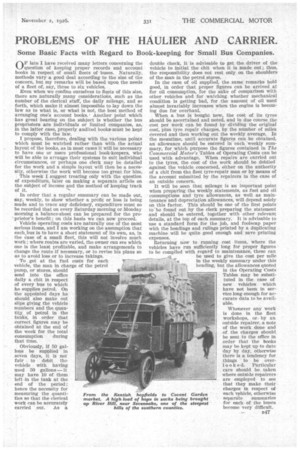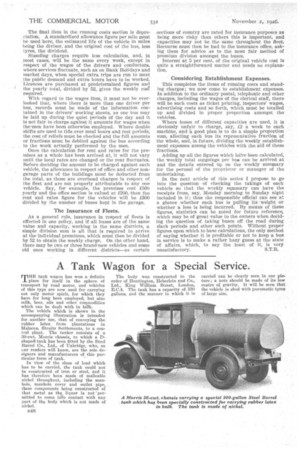PROBLEMS OF THE HAULIER AND CARRIER.
Page 73

Page 74

If you've noticed an error in this article please click here to report it so we can fix it.
Some Basic Facts with Regard to Book-keeping for Small Bus Companies.
OF late I have received many letters concerning the question of keeping proper records and account books in respect of small fleets of buses. Naturally, methods vary a good deal according to the size of the concern, but my remarks will be based upon the needs of a fleet of, say, three to six vehicles.
Even when we confine ourselves to fleets of this size, there are naturally many considerations, such as the number of the clerical staff, the daily mileage, and so forth, which make it almost impossible to lay down the law as to what is, or what is not, the best method of arranging one's account books. • Another point which has great bearing on the subject is whether the bus proprietors are individuals or limited companies, as, in the latter case, properly audited books must be kept to comply with the law.
I propose, therefore, dealing with the various points which must be watched rather than with the actual layout of the books, as in most cases it will be necessary to have one or more professional book-keepers, who will be able to arrange their systems to suit individual circumstances, or perhaps one clerk may be detailed for the work and a simple layout will then be a necessity, otherwise the work will become too great for him.
This week I suggest treating only with the question of expenditure, later on making a separate article on the subject of income and the method of keeping track of it.
In order that a regular summary can be made out, say, weekly, to show whether a profit or loss is being made and to trace any deficiency, expenditure must so be recorded that on every Saturday morning or Monday morning a balance-sheet can be prepared for the proprietor's benefit; on this basis we can now proceed.
• Vehicle operating costs are naturally one of the most serious items, and I am working on the assumption that each.bus is to have a short statement of its own, as, in the case of a small fleet, this will not involve much work ; where routes are varied, the owner can see which one is the least profitable, and make arrangements to change the route if necessary, or to revise his plans so as to avoid loss or to increase takings.
To , get at the fuel costs for each vehicle, the man in charge of the petrol pump, or stores, should send into the office daily a chit in respect of every bus to which he supplies petrol. On the appointed days he should also make out slips giving the vehicle numbers and the quantity of petrol in the tanks, in order that correct figures may be obtained at the end of the week for the total consumption during that time.
Obviously, if 50 gallons be supplied in seven days, it is not fair to debit the vehicle with having used 50 gallons — it may have 10 of them left in the tank at the end of the period ; hence the necessity for measuring the quantities so that the clerical work can be accurately carried out. As a double check, it is advisable to get the driver of the vehicle to initial the chit when it is made out; thus, the responsibility does not rest only on the shoulders of the man in the petrol stores.
In the case of oil supplied, the same remarks hold good, in order that proper figures can be arrived at for oil consumption, for the sake of comparison with other vehicles and for watching whether mechanical condition is getting bad, for the amount of oil used almost invariably increases when the engine is becoming -due for overhaul.
When a bus is, bought new, the cost of its tyres should be ascertained and noted, and in due course the cost per week can be found by dividing the original cost, plus tyre repair charges, by the number of miles covered and then working out the weekly average. In the meantime, until accurate figures can be obtained, an allowance should be entered in each weekly summary, for which purpose the figures contained in The Commercial Motor's Tables of Operating Costs can be used with advantage. When repairs are carried out to the tyres, the cost of the work should be debited against the vehicle concerned, either on the authority of a chit from the fleet tyre-repair man or by means of the account submitted by the repairers in the case of an outside concern.
It will be seen that mileage is an important point
when preparing the weekly statements, as fuel and oil consumptions and tyre allowances, as well as maintenance and depreciation allowances, will depend solely on this factor. This should be one of the first points to-be found out by the clerk preparing the statement and should be entered, together with other relevant details, at the top of each summary. It is advisable to use a standard form for the job, and foolscap paper with the headings and rulings printed by a duplicating machine will be quite good enough and save printing expenses.
Returning now to running cost items, where the vehicles have run sufficiently long for proper figures to be compiled with regard' to maintenance, these can be used to give the cost per mile in the weekly summary under this heading, but the allowances quoted in the Operating Costs Tables may be substituted in the case of new vehicles which have not been in service long enough for accurate data to be available.
Whenever any work
is done in the fleet workshops, or by an outside repairer, a note of the work done and of the charges should be sent to the office in order that the books may be kept up to date day by day, otherwise there is a tendency for things to be overlo eke d. Particular care should be taken where outside repairers are employed to see that they make their charges in respect of each vehicle, otherwise Separate summaries for each of the buses become very difficult.
The final item in the running costs section is depreciation. A standardized allowance figure per mile must be used here, the estimated life of the vehicle in miles being the divisor, and the original cost of the bus, less tyres, the dividend.
Standing charges require less calculation, and, in most cases, will be the same every week, except in respect of the wages of the drivers and conductors, where services fluctuate, such as on Bank Holidays and market days, when special extra trips are run to meet the public demand and extra hours have to be worked. Licences are purchased at predetermined figures and the yearly total, divided by 52, gives the weekly cost required.
With regard to the wages item, it must not be overlooked that, where there is more than one driver per bus, records must be made of the information contained in the drivers' working sheets, as one bus may be laid up during the quiet periods of the day and it is not fair to charge against it amounts for wages when the,men have been otherwise employed. Where double shifts are used to tide over meal hours and rest periods, the cost of reliefs must be checked and the full amounts or fractions must be debited against the bus according to the work aCtually performed by the men.
Once the calculation for rent and rates for the premises as a whole has been arrived at, it will not vary until the local rates are changed or the rent fluctuates. Before deciding the amount to be charged against each vehicle, the allowance in respect of office and other nongarage parts of the buildings must be deducted from the total, as those are overhead charges in respect of the fleet and are not properly attributable to any one vehicle. Say, for example, the premises cost £500 yearly and the office section is valued at £200, then the rent and rates figure for the vehicles will be £300 divided by the number of buses kept in the garage.
The Insurance of Fleets.
As a general rule, insurance in respect of fleets is effected in one policy, and if all buses are of the same value and capacity, working in the same districts, a simple division sum is all that is required to arrive at the individual preminms, which must then be divided by 52 to obtain the weekly charge. On the other hand, there may be two or three brand-new vehicles and some old ones working in different districts—as certain sections of country are rated Tor insurance purposes as being more risky than others this is important, and capacities may not be the same throughout the fleet. Recourse must then be had to the insurance office, asking them for advice as to the most fair method of premium division amongst the buses.
Interest at 5 per cent, of the original vehicle cost is quite a straightforward matter and needs no explanation.
Considering Establishment Expenses.
This completes the items of running costs and standing charges; we now come to establishment expenses. In addition to the ordinary postal, telephonic and other charges, including the wages of the clerical staff, there will be such costs as ticket printing, inspectors' wages, advertising costs and so forth, which must be totalled up and divided in proper Proportion amongst the vehicles.
Where buses of different capacities are used, it is obviously unfair to charge, say, /2 a week to each machine, and "it good plan is to do a simple proportion sum, allotting each bus its representative fraction of the whole, and, in future, dividing the weekly establishment expenses among the vehicles with the aid of these fractions.
Adding up all the figures which have been calculated, the weekly total outgoings per bust can be arrived at and the details entered up on the weekly summary for the perusal of the proprietor or manager of the undertaking.
In the next article of this series I propose to go into the question of checking the takings of each vehicle so that the weekly summary can have the receipts from, say, 3...londaY morning to Sunday night included in it; thus the responsible official can see at a glance whether each bus is pulling its weight or whether a loss is being incurred. By means of these figures, statistics can be noted for future reference, which may be of great value to the owners when deeiditig the question of taking buses off the road during slack periods and other such points. Without proper figures upon which to base calculations, the only method of saying whether it is profitable or not to keep a bus in service is to make a rather hazy guess at the state of affairs, which, to say the least of it, is very unsatisfactory. S.T.R.




























































































































